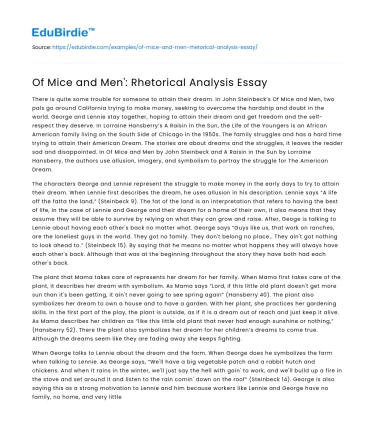There is quite some trouble for someone to attain their dream. In John Steinbeck’s Of Mice and Men, two pals go around California trying to make money, seeking to overcome the hardship and doubt in the world. George and Lennie stay together, hoping to attain their dream and get freedom and the self-respect they deserve. In Lorraine Hansberry’s A Raisin in the Sun, the Life of the Youngers is an African American family living on the South Side of Chicago in the 1950s. The family struggles and has a hard time trying to attain their American Dream. The stories are about dreams and the struggles, it leaves the reader sad and disappointed. In Of Mice and Men by John Steinbeck and A Raisin in the Sun by Lorraine Hansberry, the authors use allusion, imagery, and symbolism to portray the struggle for The American Dream.
The characters George and Lennie represent the struggle to make money in the early days to try to attain their dream. When Lennie first describes the dream, he uses allusion in his description. Lennie says “A life off the fatta the land,” (Steinbeck 9). The fat of the land is an interpretation that refers to having the best of life, In the case of Lennie and George and their dream for a home of their own, it also means that they assume they will be able to survive by relying on what they can grow and raise. After, Geoge is talking to Lennie about having each other's back no matter what. George says “Guys like us, that work on ranches, are the loneliest guys in the world. They got no family. They don't belong no place… They ain't got nothing to look ahead to.” (Steinbeck 15). By saying that he means no matter what happens they will always have each other's back. Although that was at the beginning throughout the story they have both had each other's back.
Save your time!
We can take care of your essay
- Proper editing and formatting
- Free revision, title page, and bibliography
- Flexible prices and money-back guarantee
The plant that Mama takes care of represents her dream for her family. When Mama first takes care of the plant, it describes her dream with symbolism. As Mama says “Lord, if this little old plant doesn't get more sun than it's been getting, it ain't never going to see spring again” (Hansberry 40). The plant also symbolizes her dream to own a house and to have a garden. With her plant, she practices her gardening skills. In the first part of the play, the plant is outside, as if it is a dream out of reach and just keep it alive. As Mama describes her children as “like this little old plant that never had enough sunshine or nothing,” (Hansberry 52). There the plant also symbolizes her dream for her children’s dreams to come true. Although the dreams seem like they are fading away she keeps fighting.
When George talks to Lennie about the dream and the farm. When George does he symbolizes the farm when talking to Lennie. As George says, “We'll have a big vegetable patch and a rabbit hutch and chickens. And when it rains in the winter, we'll just say the hell with goin' to work, and we'll build up a fire in the stove and set around it and listen to the rain comin' down on the roof” (Steinbeck 14). George is also saying this as a strong motivation to Lennie and him because workers like Lennie and George have no family, no home, and very little control over their lives. After when Candy says they could still have the farm together, George says, “I think I knew from the very first. I think I knew we'd never do her. He usta like to hear about it so much I got to thinking maybe we would” (Steinbeck 94). George says this because Lennie was the main reason why he wanted that and now without Lennie, he feels like it is useless. Although without Lennie he still supports the dream and wants it and strives for it.
The authors communicate a strong message about The American Dream through literary elements like symbolism. Symbolism, allusion, and imagery are a big part of dreams throughout both of the novels. The author's thought about The American Dream is obvious in Of Mice and Men and A Raisin in the Sun.
Works Cited
- Hansberry, Lorraine. A Raisin in the Sun. Glencoe, 1958, New York.
- Steinbeck, John. Of Mice and Men. Covici Friede, 1937, New York.






 Stuck on your essay?
Stuck on your essay?

